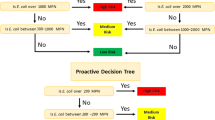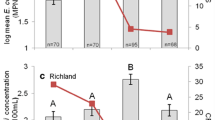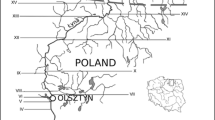Abstract
Fecal contamination of coastal recreational water is a public health concern, which coastal managers monitor using fecal indicator bacteria (FIB). In this study, 20 stations in nine United States (US) estuaries were monitored over three years for FIB (enterococci, fecal coliforms, Escherichia coli, and Clostridium perfringens) and fecal indicator virus (F+ coliphage and somatic coliphage) concentrations in water. Fecal indicator concentrations were significantly correlated with some environmental variables (rainfall, water temperature, salinity, and sample collection time) across all estuaries. Multilinear models utilizing environmental parameters predicted anywhere from 69% (C. perfringens) to 19% (F+ coliphages) of fecal indicator variability. Coliphage equivalence to US Environmental Protection Agency marine water enterococci criteria was estimated with 95% confidence intervals, though these findings should be interpreted with caution because enterococci densities were weakly positively correlated to coliphage densities (R=0.435 somatic coliphages, R=0.367 F+ coliphages). In a comparison of coliphage methods, enrichment (EPA Method 1601) outperformed single agar layer (EPA Method 1602) and membrane filtration. In summary, the relationships among coliphage methods, between fecal indicators, and their interactions with environmental variables represent findings from a geographically diverse set of US estuaries with different fecal waste sources and loads, which suggests these findings are highly generalizable.
Similar content being viewed by others
References
APHA (1998) Standard methods for the examination of water and wastewater. American Public Health Association
Boehm AB, Grant SB, Kim JH, Mowbray SL, McGee CD, Clark CD, Foley DM, Wellman DE (2002) Decadal and shorter period variability of surf zone water quality at Huntington Beach, California. Environ Sci Technol 36(18):3885–3892
Boehm AB, Yamahara KM, Love DC, Peterson BM, McNeill K, Nelson KL (2009) Covariation and photoinactivation of traditional and novel indicator organisms and human viruses at a sewage-impacted marine beach. Environ Sci Technol 43(21):8046–8052
Cabelli V (1983) Health effects criteria for marine recreational waters. USEPA-600-1-80-031. Cincinnati, Ohio
Caffrey J, Brown M, Tyler WB, Silberstein M (2002) Changes in a California estuary: A profile of Elkhorn Slough. Elkhorn Slough Foundation, California
Chung H, Jaykus LA, Lovelace G, Sobsey MD (1998) Bacteriophages and bacteria as indicators of enteric viruses in oysters and their harvest waters. Water Sci Technol 38(12):37–44
Colford JM, Wade TJ, Schiff KC, Wright CC, Griffith JF, Sandhu SK, Burns S, Sobsey M, Lovelace G, Weisberg SB (2007) Water quality indicators and the risk of illness at beaches with non-point sources of fecal contamination. Epidemiology 18(1):27–35
Contreras-Coll N, Lucena F, Mooijman K, Havelaar A, Pierz V, Boque M, Gawler A, Höller C, Lambiri M, Mirolo G, Moreno B, Niemi M, Sommer R, Valentin B, Wiedenmann A, Young V, Jofre J (2002) Occurrence and levels of indicator bacteriophages in bathing waters throughout Europe. Water Res 36(20):4963–4974
Corbett SJ, Rubin GL, Curry GK, Kleinbaum DG (1993) The health effects of swimming at Sydney beaches. The Sydney Beach. Users Study Advisory Group. Am J Publ Health 83(12):1701–1706
Doré WJ, Henshilwood K, Lees DN (2000) Evaluation of F-specific RNA bacteriophage as a candidate human enteric virus indicator for bivalve molluscan shellfish. Appl Environ Microbiol 66(4):1280–1285
Fujioka RS, Yoneyama BS (2002) Sunlight inactivation of human enteric viruses and fecal bacteria. Water Sci Technol 46(11–12):291–295
Garrido-Perez M, Anfuso E, Acevedo A, Perales-Vargas-Machuca J (2008) Microbial indicators of faecal contamination in waters and sediments of beach bathing zones. Int J Hyg Environ Health 21(1):510–517
Haile RW, Witte JS, Gold M, Cressey R, McGee C, Millikan RC, Glasser A, Harawa N, Ervin C, Harmon P, Harper J, Dermand J, Alamillo J, Barrett K, Nides M, Wang G (1999) The health effects of swimming in ocean water contaminated by storm drain run-off. Epidemiology 10(4):355–363
Havelaar AH, van Olphen M, Drost YC (1993) F-specific RNA bacteriophages are adequate model organisms for enteric viruses in fresh water. Appl Environ Microbiol 59(9):2956–2962
He L-ML, He Z-L (2008) Water quality prediction of marine recreational beaches receiving watershed baseflow and stormwater run-off in southern California, USA. Water Res 42(10–11):2563–2573
Hsu FC, Shieh YS, van Duin J, Beekwilder MJ, Sobsey MD (1995) Genotyping male-specific RNA coliphages by hybridization with oligonucleotide probes. Appl Environ Microbiol 61(11):3960–3966
Ibarluzea JM, Santa Marina L, Moreno B, Serrano E, Larburu K, Maiztegi MJ, Yarzabal A (2007) Somatic coliphages and bacterial indicators of bathing water quality in the beaches of Gipuzkoa, Spain. J Water Health 5(3):417–426
Jiang S, Chu W, He J (2007) Seasonal detection of human viruses and coliphage in Newport Bay, California. Appl Environ Microbiol 73(20):6468–6474
Jiang S, Noble R, Chu W (2001) Human adenoviruses and coliphages in urban run-off-impacted coastal waters of southern California. Appl Environ Microbiol 67(1):179–184
Lodder WJ, de Roda Husman AM (2005) Presence of noroviruses and other enteric viruses in sewage and surface waters in the Netherlands. Appl Environ Microbiol 71(3):1453–1461
Love DC, Sobsey M (2007a) A simple and rapid F+ coliphage detection and serotyping system for water quality monitoring at Doheny Beach, CA. In: Water qual technol conf of the Am Water Works Assoc, Charlotte, NC
Love DC, Sobsey MD (2007b) Simple and rapid F+ coliphage culture, latex agglutination, and typing (CLAT) assay to detect and source track fecal contamination. Appl Environ Microbiol 73(13):4110–4118
Lowther JA, Henshilwood K, Lees DN (2008) Determination of norovirus contamination in oysters from two commercial harvesting areas over an extended period, using semiquantitative real-time reverse transcription PCR. J Food Prot 71(7):1427–1433
Lucena F, Méndez X, Morón A, Calderón E, Campos C, Guerrero A, Cárdenas M, Gantzer C, Shwartzbrood L, Skraber S, Jofre J (2003) Occurrence and densities of bacteriophages proposed as indicators and bacterial indicators in river waters from Europe and South America. J Appl Microbiol 94(5):808–815
Lugoli F, Leopizzi MI, De Donno A (2009) Viral indicators of hygienic-sanitary quality: Detection of somatic coliphages in the southern Adriatic Sea water quality. Expo Health 1(3–4):171–177
Mocé-Llivina L, Lucena F, Jofre J (2005) Enteroviruses and bacteriophages in bathing waters. Appl Environ Microbiol 71(11):6838–6844
Muniesa M, Jofre J, García-Aljaro C, Blanch AR (2006) Occurrence of Escherichia coli O157:H7 and other enterohemorrhagic Escherichia coli in the environment. Environ Sci Technol 40(23):7141–7149
Nasser AM, Zaruk N, Tenenbaum L, Netzan Y (2003) Comparative survival of Cryptosporidium, coxsackievirus A9 and Escherichia coli in stream, brackish and sea waters. Water Sci Technol 47(3):91–96
NOAA (2010) National Climate Data Center, US Department of Commerce. http://www.ncdc.noaa.gov/oa/ncdc.html
NRC (2004) Indicators for waterborne pathogens, pp 1–315
Prieto MD, Lopez B, Juanes JA, Revilla JA, Llorca J, Delgado-Rodríguez M (2001) Recreation in coastal waters: Health risks associated with bathing in seawater. J Epidemiol Community Health 55(6):442–447
Ruecker NJ, Braithwaite SL, Topp E, Edge T, Lapen DR, Wilkes G, Robertson W, Medeiros D, Sensen CW, Neumann NF (2007) Tracking host sources of Cryptosporidium spp. in raw water for improved health risk assessment. Appl Environ Microbiol 73(12):3945–3957
Sanders BF, Arega F, Sutula M (2005) Modeling the dry-weather tidal cycling of fecal indicator bacteria in surface waters of an intertidal wetland. Water Res 39(14):3394–3408
Schwab KJ (2007) Are existing bacterial indicators adequate for determining recreational water illness in waters impacted by non-point pollution? Epidemiology 18(1):21–22
Shibata T, Solo-Gabriele H, Fleming L, Elmir S (2004) Monitoring marine recreational water quality using multiple microbial indicators in an urban tropical environment. Water Res 38:3119–3131
Shieh YC, Baric RS, Woods JW, Calci KR (2003) Molecular surveillance of enterovirus and norwalk-like virus in oysters relocated to a municipal-sewage-impacted gulf estuary. Appl Environ Microbiol 69(12):7130–7136
Sobsey MD, Battigelli DA, Handzel TR, Schwab KJ (1995) Male-specific coliphages as indicators of viral contamination of drinking water. American Water Works Association Research Foundation
Sobsey MD, Schwab KJ, Handzel TR (1990) A simple membrane filter method to concentrate and enumerate male-specific RNA coliphages. J Am Water Works Assoc 82:52–59
USEPA (1986) Ambient water quality criteria for bacteria—1986. EPA 440/5/84-002
USEPA (2000) Improved enumeration methods for the recreational water quality indicators: Enterococci and Escherichia coli. EPA/821/R-97/004
USEPA (2001a) Male-specific (F+) and somatic coliphage in water by single agar layer (SAL) procedure. EPA-821-R-01-029
USEPA (2001b) Male-specific (F+) and somatic coliphage in water by two-step enrichment procedure. EPA-821-R-01-030
USEPA (2002a) Enterococci in water by membrane filtration using membrane-Enterococcus indoxyl-B-D-glucoside agar (mEI). EPA 821-R-02-022
USEPA (2002b) Escherichia coli (E. coli) in water by membrane filtration using modified membrane-thermotolerant Escherichia coli agar (Modified mTEC). EPA 821-R-02-023
Wade TJ, Pai N, Eisenberg JNS, Colford JM (2003) Do U.S. Environmental Protection Agency water quality guidelines for recreational waters prevent gastrointestinal illness? A systematic review and meta-analysis. Environ Health Perspect 111(8):1102–1109
Wait DA, Sobsey MD (2001) Comparative survival of enteric viruses and bacteria in Atlantic Ocean seawater. Water Sci Technol 43(12):139–142
WHO (2003) Guidelines for safe recreational water environments. 1. Coastal and fresh waters
Wiedenmann A, Krüger P, Dietz K, López-Pila JM, Szewzyk R, Botzenhart K (2006) A randomized controlled trial assessing infectious disease risks from bathing in fresh recreational waters in relation to the concentration of Escherichia coli, intestinal enterococci, Clostridium perfringens, and somatic coliphages. Environ Health Perspect 114(2):228–236
Zuniga J (2005) Tainted waters. The San Diego Union Tribune. http://legacy.signonsandiego.com/uniontrib/20050527/news_6m27sewage.html. Accessed 10 May 2010
Author information
Authors and Affiliations
Corresponding author
Rights and permissions
About this article
Cite this article
Love, D.C., Lovelace, G.L., Money, E.S. et al. Microbial Fecal Indicator Concentrations in Water and Their Correlation to Environmental Parameters in Nine Geographically Diverse Estuaries. Water Qual Expo Health 2, 85–95 (2010). https://doi.org/10.1007/s12403-010-0026-3
Received:
Accepted:
Published:
Issue Date:
DOI: https://doi.org/10.1007/s12403-010-0026-3




